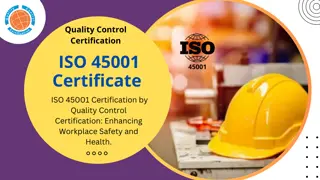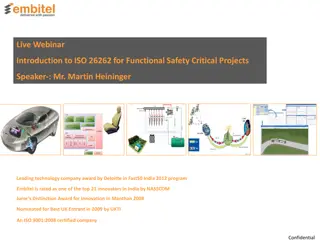Certification ISO
ISO u2013 Organisation internationale de normalisation est une organisation indu00e9pendante qui du00e9finit des normes pour les entreprises en termes de qualitu00e9, de su00e9curitu00e9 et du2019environnement du systu00e8me de gestion. Lu20
Download Presentation

Please find below an Image/Link to download the presentation.
The content on the website is provided AS IS for your information and personal use only. It may not be sold, licensed, or shared on other websites without obtaining consent from the author.If you encounter any issues during the download, it is possible that the publisher has removed the file from their server.
You are allowed to download the files provided on this website for personal or commercial use, subject to the condition that they are used lawfully. All files are the property of their respective owners.
The content on the website is provided AS IS for your information and personal use only. It may not be sold, licensed, or shared on other websites without obtaining consent from the author.
E N D
Presentation Transcript
Certification ISO: Upholding Standards of Quality and Excellence In today's global economy, adherence to international standards is paramount for businesses striving to maintain quality, efficiency, and customer satisfaction. The International Organization for Standardization (ISO) develops provide frameworks and guidelines for various industries and sectors worldwide. ISO certification validates an organization's adherence to these standards, demonstrating its commitment to excellence and continuous improvement. This article explores the significance of ISO certification, the process of obtaining ISO certification, its benefits for organizations, and the challenges associated with certification. and publishes standards that Introduction ISO certification serves as a hallmark of quality and reliability, signaling to stakeholders that an organization complies with internationally recognized standards. From manufacturing and service industries to healthcare and technology businesses streamline operations, enhance product quality, and mitigate risks. This article delves into the multifaceted aspects of ISO certification, illustrating its pivotal role in modern business practices. sectors, ISO certification helps Importance of ISO Certification ISO management, environmental sustainability, health and safety. Adhering to these standards enables organizations to implement best practices, improve operational efficiency, and meet regulatory requirements. ISO certification validates that an organization's processes, products, or services conform to these standards, instilling confidence in customers, partners, and stakeholders. standards cover a broad spectrum information of areas, security, including and quality occupational One significant aspect of ISO certification is its role in fostering international trade. Compliance with ISO standards facilitates market access by ensuring products and services meet global expectations for quality and safety. For example, ISO 9001 certification, focusing on quality management systems, enhances an organization's credibility and competitiveness in the marketplace. Similarly, ISO 14001 certification demonstrates commitment to environmental responsibility, appealing to environmentally conscious consumers and regulatorybodies. Process of Obtaining ISO Certification The journey to ISO certification involves several systematic steps to assess, implement, and audit compliance with ISO standards: 1.Gap Analysis and Preparation: Initially, organizations conduct a gap analysis to evaluate existing processes and identify areas that require improvement to meet ISO standards. This phase involves reviewing current practices, documenting procedures, and aligning operations with ISO requirements. 2.Implementation implement necessary changes and establish systems to comply with ISO standards. of ISO Standards: Once gaps are identified, organizations
This quality management systems (QMS) or environmental management systems (EMS) into daily operations. may include revising policies, training employees, and integrating 3.Internal Audits and Evaluation: Internal audits are conducted to assess the effectiveness of implemented systems and processes. Qualified auditors review documentation, interview personnel, and analyze data to ensure conformity with ISO standards. This internal assessment helps identify non-conformities and areas for furtherimprovement. 4.Certification Audit by External Body: After successful completion of internal audits and corrective actions, organizations undergo accredited external certification body. External auditors conduct a comprehensive assessment to verify compliance with ISO standards and determine eligibility for certification. a certification audit by an 5.Continuous organizations are required to maintain compliance through continuous improvement initiatives and periodic surveillance audits. These audits ensure ongoing adherence to ISO standards and drive organizational excellence over time. Improvement and Surveillance Audits: Upon certification, Benefits of ISO Certification for Organiaations ISO certification offers numerous benefits that contribute to organizational growth, efficiency, and stakeholder confidence: 1.Enhanced organizational credibility by demonstrating commitment to quality, safety, and environmental stewardship. Certified organizations gain preferential access to global markets and opportunities for collaboration with international partners. Credibility and Market Access: ISO certification enhances 2.Improved operational efficiency optimizing increased delivery of high-qualityproducts and services. Operational Efficiency: standardizing Implementing processes, ISO reducing standards fosters and by waste, resource allocation. Streamlined operations lead to cost savings, productivity, and enhanced customer satisfaction through consistent 3.Risk Management and Compliance: ISO standards provide frameworks for risk management and regulatory compliance, helping organizations mitigate risks and adhere to legal obligations. Certification signifies proactive risk mitigation strategies and readiness to address potentialchallenges. 4.Employee Engagement and Organiaational Culture: ISO certification promotes a culture of continuous improvement and employee engagement. Employees are empowered through training and involvement in QMS or EMS implementation, fostering a collaborative environment focused on achieving organizational goals. Challenges Associated with ISO Certification
While challenges throughoutthe certification process: ISO certification offers substantial benefits, organizations may encounter 1.Resource Allocation and Costs: Implementing ISO standards requires significant investments in time, resources, and training. Costs associated with certification audits, consultancy fees, and infrastructure upgrades can be substantial, particularly for small and medium-sized enterprises (SMEs). 2.Complexity conducting audits, and maintaining compliance with ISO standards can be complex and demanding. Organizations must allocate sufficient resources and expertise to navigate certification requirements effectively. and Documentation: The process of documenting procedures, 3.Integration Across Functions and Departments: Achieving ISO certification often necessitates collaboration across departments and functions within an organization. Ensuring alignment of processes and challenging, requiring effective communication and leadership. practices across diverse areas can be 4.Adaptation to Changing Standards: ISO standards are periodically revised to reflect evolving industry trends, technological Organizations must stay informed about updates to standards and adapt their QMS or EMS accordingly to maintain certification. advancements, and regulatory changes. Conclusion In conclusion, certification iso represents a commitment to excellence, quality, and continuous improvement in business operations. It provides organizations with a competitive edge, enhances credibility in global markets, and fosters stakeholder confidence. While the certification process involves challenges such as resource allocation and compliance complexities, the benefits including improved operational efficiency, risk management, and employee engagement justify the investment. As organizations embrace ISO standards to drive innovation and sustainability, certification serves as a cornerstone for achieving long-term success and maintaining leadership in a competitive marketplace.























